China confirms leadership in the Asian lunar race
In the zero years in Asia began the second "moon race". Unlike the first, when the USSR and the USA competed in the 1960s, there were more participating countries, but budgets were smaller, and the general terms were longer. At the start there were three participants - India, China, Japan. Now a clear leader was determined. China took the lead in 2013, having made a soft landing first and landed a lunar rover. The Chang'e-4 automatic interplanetary station flying to the Moon will make the first landing on the far side of the moon (which required a separate mission to provide communication) and is one of the steps of the large program.

A source
In general, the study of the moon can be divided into four stages. Historically, the very first missions were to fly past the moon or crash the spacecraft on its surface, but now it is irrational, because the interplanetary station would have been working for the moon for too short a time. However, missions leaving Earth may turn on their instruments, flying past the moon, for example, on their way to Mars.
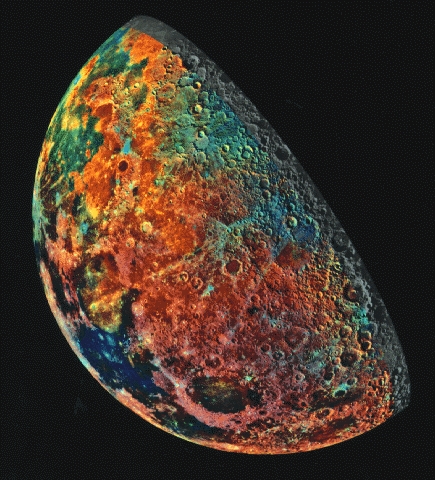
Composite photo from GALILEO probe flying to Jupiter, NASA image
')
The first full stage - a probe in the orbit of the moon. This is not entirely simple, because, due to the uneven gravitational field of the moon, there are only a few stable orbits on which to work for years. At this level, it is already possible to solve problems of not only state prestige, repeating the achievements of the past, but also to collect useful scientific data by scanning the moon in different ranges.
The second stage is a soft landing. Here, the task is complicated by the need to extinguish at least 1.68 km / s of speed (from a low orbit), but the scientific data are complemented by a diverse geology, and you can always choose an interesting place for landing, where no one has yet visited. The landing station can be supplemented with a lunar rover, which will dramatically expand both the amount of scientific data and the number of beautiful photos that the whole world will see.
The third stage is the return of samples. Engineering challenges are complemented by the need to solve the problem of starting from the moon, navigation and aiming on the way home, as well as a soft landing on the Earth. But the brought samples with delight will be disassembled by scientists, and there will be extremely vivid evidence of the country's success in the form of exhibits in museums.
The fourth stage is a manned program. In a global sense, of course, someday mankind will begin to live in space on an ongoing basis, but so far the manned lunar program is very expensive and is available only to the largest economies of the world or to the joint work of many countries.
All participants of the new moon race started almost at the same time. Formally, of course, there was the Japanese mission of 1990 from two satellites, Khiten and Khagoromo, but a break of 17 years before the next flight does not allow it to be counted as part of a sequential program. Still, it is not surprising that the Japanese first flew. On September 14, 2007, three moons went to the Moon - the big Kaguya and two small ones, Okina and Ouna.

"Kaguya" separates small satellites, image JAXA
Kaguya carried 13 instruments, among which were cameras, spectrometers, a radar, a laser altimeter, plasma detectors and others. Two small satellites used a radio band: Okina worked as a transponder and measured the gravitational field of the moon using the Doppler effect, Ouna used interferometry with a superlong base for the same purpose, because near the lunar limb the Doppler effect did not work (the probe shifted sideways and did not accelerate / decelerate relative to the earth observer).
As a result of the work of the Japanese "triad" we learned a lot of interesting things. First of all, contrary to scientists' assumptions, no point on the lunar surface was lit all the time. In the area of the north pole, the maximum illumination was 89%, of the south - 86%. This imposes certain requirements on the design of the polar landing stations or the lunar base - if there were always lighted places, then there could be deployed solar panels without the need for batteries. But the zones of constant shadow were found in abundance, and this is good, because it is cold and there is water ice in some form.

Pole Light Map, JAXA Image
Alas, we could not find it on the surface of the ice - a very sensitive camera, looking into the crater of Shackleton, did not notice the brightness.
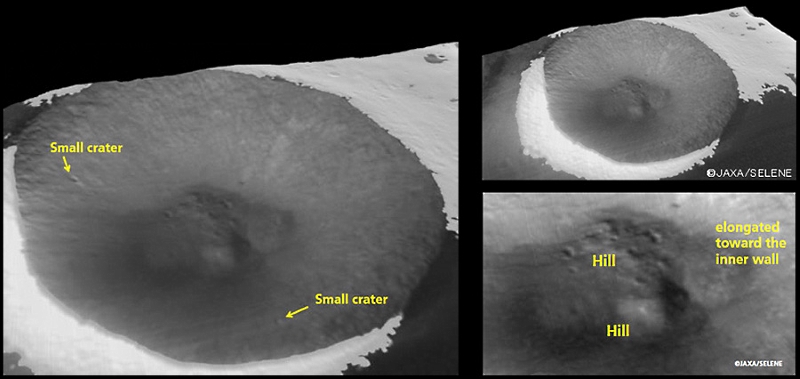
Photo of Shackleton crater, image JAXA
In addition, a very detailed map of the Moon and its gravitational anomalies was compiled, as well as layers of basalt and regolith in the lunar seas and anorthosite layer in the Tycho crater.
A little more than a month later, on October 22, the Chinese Chang'e-1 (named after the goddess of the Moon) went to the moon. Engineering projects last for years, so this means that the work was carried out simultaneously and it is already possible to speak of a “race”. The Chinese apparatus was slightly lighter (2.3 tons versus 2.9 “Kagui”), but it carried 24 instruments — cameras, spectrometers, radiometers, a particle detector, a laser altimeter, and others.
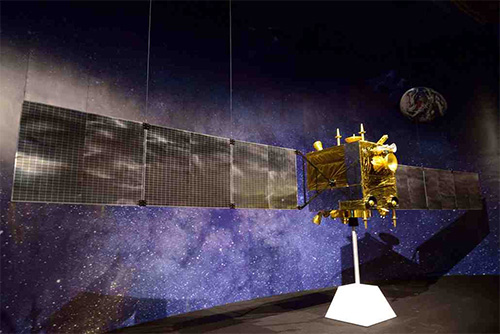
Layout "Chang'e-1", photo Hong Kong Science Museum
The result of the apparatus was the highest quality map of the moon at that time and a lot of data on the distribution of chemical elements.

The distribution of iron, in point b on the left, the data of “Chang'e-1”, on the right - American Clementine 1994, source

The distribution of uranium (top) and potassium on the moon, the source
A year later, on October 21, 2008 (which also means that the work was carried out in parallel), an Indian probe Chandrayaan-1 with a penetrator flew to the moon. He was the lightest (1.3 tons), but became the biggest newsmaker. According to his data, the presence of water on the moon was confirmed. And at once in two ways - from an orbiter and a penetrator. On the satellite, one of the 11 scientific instruments was the American Moon Mineralogy Mapper, according to which they received a water distribution map (blue) and iron (red) on the moon.
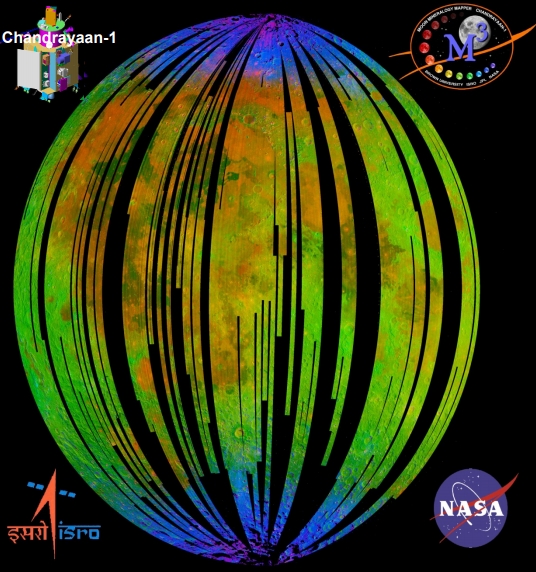
Water and Iron Distribution, ISRO / NASA Image
And on the penetrator there was a very sensitive spectrometer, which, during the descent, recorded the presence of water molecules in the near-moon space.
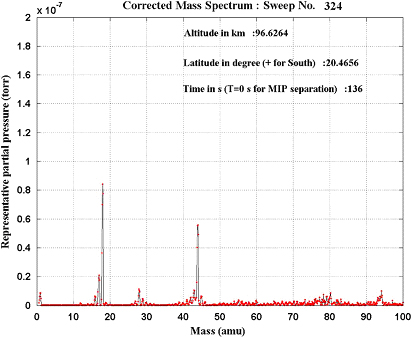
The highest peak at 18 is water. ISRO image
In addition, the device refuted the widespread belief that regolith almost completely absorbs the solar wind. In reality, it turned out that 20% is reflected back.
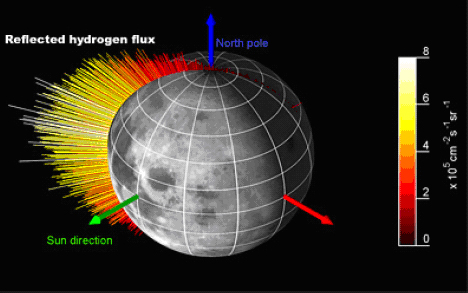
Solar wind reflection distribution, ISRO image
All three vehicles of the first wave completed their work in 2009. The Japanese and Chinese were controlled in orbit, and the Indian broke and still revolves around the moon.
At the end of the 2000s, Japan was seen as the most likely leader of the Asian lunar race. But in reality, it turned out to be China. Already on October 1, 2010, the Chang'e-2 went to the flight, which in terms of the duration and complexity of the mission was comparable with NASA or ESA devices. Having worked until the summer of 2011 in lunar orbit, the probe went into halo-orbit around point L 2 Earth-Moon (located behind the Moon), and then went to the asteroid (4179) Tautatis, visiting which, became a device for working off long-distance communications and checking long-functioning interplanetary stations - it has already flown a hundred times farther from the moon and is still working.

The main task of Chang'e-2 was to draw up a detailed map and selection of places for future landings. To this end, it was transferred to orbit with a pericenter (lowest point) of just 15 km. This made it possible to obtain a stereoscopic map of the entire surface with a resolution of 7 meters per pixel and individual images with a resolution of 1.3 meters, only five times worse than the current record holder, NASA LRO, which for this purpose was transferred to a special lowered orbit after the execution of the main program.

Photo by the Chinese Space Agency

Asteroid Tautatis. Photo "Xinhua" / CAS
And in 2013, China successfully completed the second stage - a soft landing. The Chang'e-3 apparatus with the Yuytu moonwalker successfully ducked on December 14, albeit with an undershoot relative to the planned area.

Landing stage, photo by the Chinese Space Agency

Lunokhod, photo by the Chinese Space Agency
The Lunokhod worked for 31 months (even if it lost the ability to move on the second), but the landing station is still functioning (in the summer they recorded a signal from it). For the first time, a long-term observatory appeared on the surface of the moon. The work resulted in data on geology, astronomical observations and, of course, a proud photo of the flag of China on the surface of the moon.

Soil structure under the landing site, GPR data, CAS image

Plasmasphere of the Earth in extreme ultraviolet, image CAS
In parallel, China began to prepare for the next step - the return of samples of lunar soil. To this end, on October 23, 2014, a test stand “Chang'e-5T1” was launched to the Moon, which checked the technological solutions for a soft landing on Earth of the apparatus returning with a second space velocity.

Lander after landing
China had a second, reserve, set of landing steps and a lunar rover in case of failure of the Chang'e-3. Once the mission was successful, the next task made sense to complicate. Therefore, the fourth unit decided to send to the back of the moon. But for this you need a repeater - it is impossible to directly communicate with the back side. The experiments of “Chang'e-2” with the Lagrange point L 2 were also conducted for this reason - for the repeater it is a very convenient orbit.
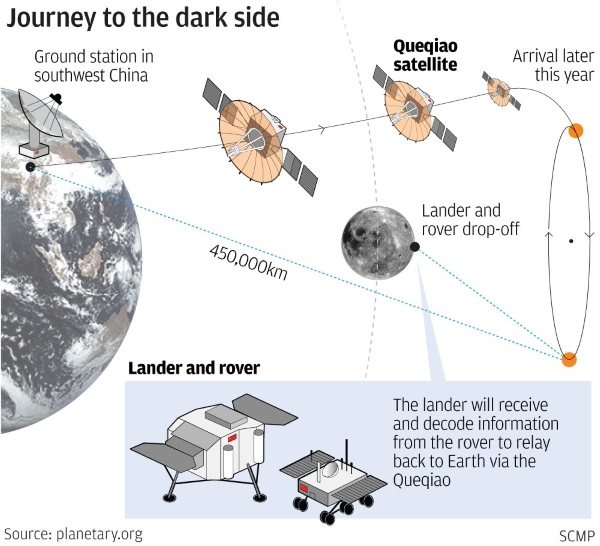
Planetary Society image
On May 20, 2018, the Queuxiao apparatus set off to the moon. The name (“Shorter bridge”) is taken from a Chinese legend ; it is a bridge of birds across the Milky Way, which connects lovers once a year. Its main task is to become a repeater for the reverse side, but scientific equipment was also installed on it — the Dutch low-frequency radio telescope. Two 45-kilogram Lunjiang-1 and -2 satellites flew together with Queuxiao. Unfortunately, one broke down and was unable to go into circumlunar orbit, but the second is successfully functioning, watching the sky in the radio range and taking photographs - it has a camera made in Saudi Arabia.

Model "Quetqiao" source

Views of the Moon with Lunjiang-2, photo by CNSA
And on December 7, 2018 the Chang'e-4 flew, which would have to land in the South Pole-Aitken basin. Its design is very similar to Chang'e-3, but there are differences. An ultraviolet telescope was removed from the landing platform, but a second camera was installed, a neutron dosimeter, a low-frequency spectrometer (for studying solar flares) and a 3-kg container with seeds and insect eggs, which should form an ecosystem closed in oxygen. The manipulator was removed from the rover, but a radioisotope heater was installed (now it’s expected to last 3 months), a VINS spectrometer and an ASAN Swedish particle neutral analyzer. The georadar on the moon rover was left, so the photos will be supplemented by the structure of the soil tens of meters down.
The launch was successful, the device is now on its way to the moon. The trajectory is so good that the first correction on Saturday was canceled. The second correction was performed on Sunday. The landing is expected in early 2019, because at first the device will go into orbit around the moon and will stay there for a while, checking the systems and preparing for landing on the moon.
Well, returning to the Asian lunar race, it is worth noting that in 2019 there will be two more events connected with it. On January 31, the launch of the Indian mission Chandrayaan-2 from the orbiter and the landing gear with the moon rover is scheduled. And in December 2019, the first Chinese mission on the delivery of lunar soil, Chang'e-5, is to fly.

A source
Formula race
In general, the study of the moon can be divided into four stages. Historically, the very first missions were to fly past the moon or crash the spacecraft on its surface, but now it is irrational, because the interplanetary station would have been working for the moon for too short a time. However, missions leaving Earth may turn on their instruments, flying past the moon, for example, on their way to Mars.

Composite photo from GALILEO probe flying to Jupiter, NASA image
')
The first full stage - a probe in the orbit of the moon. This is not entirely simple, because, due to the uneven gravitational field of the moon, there are only a few stable orbits on which to work for years. At this level, it is already possible to solve problems of not only state prestige, repeating the achievements of the past, but also to collect useful scientific data by scanning the moon in different ranges.
The second stage is a soft landing. Here, the task is complicated by the need to extinguish at least 1.68 km / s of speed (from a low orbit), but the scientific data are complemented by a diverse geology, and you can always choose an interesting place for landing, where no one has yet visited. The landing station can be supplemented with a lunar rover, which will dramatically expand both the amount of scientific data and the number of beautiful photos that the whole world will see.
The third stage is the return of samples. Engineering challenges are complemented by the need to solve the problem of starting from the moon, navigation and aiming on the way home, as well as a soft landing on the Earth. But the brought samples with delight will be disassembled by scientists, and there will be extremely vivid evidence of the country's success in the form of exhibits in museums.
The fourth stage is a manned program. In a global sense, of course, someday mankind will begin to live in space on an ongoing basis, but so far the manned lunar program is very expensive and is available only to the largest economies of the world or to the joint work of many countries.
Start
All participants of the new moon race started almost at the same time. Formally, of course, there was the Japanese mission of 1990 from two satellites, Khiten and Khagoromo, but a break of 17 years before the next flight does not allow it to be counted as part of a sequential program. Still, it is not surprising that the Japanese first flew. On September 14, 2007, three moons went to the Moon - the big Kaguya and two small ones, Okina and Ouna.

"Kaguya" separates small satellites, image JAXA
Kaguya carried 13 instruments, among which were cameras, spectrometers, a radar, a laser altimeter, plasma detectors and others. Two small satellites used a radio band: Okina worked as a transponder and measured the gravitational field of the moon using the Doppler effect, Ouna used interferometry with a superlong base for the same purpose, because near the lunar limb the Doppler effect did not work (the probe shifted sideways and did not accelerate / decelerate relative to the earth observer).
As a result of the work of the Japanese "triad" we learned a lot of interesting things. First of all, contrary to scientists' assumptions, no point on the lunar surface was lit all the time. In the area of the north pole, the maximum illumination was 89%, of the south - 86%. This imposes certain requirements on the design of the polar landing stations or the lunar base - if there were always lighted places, then there could be deployed solar panels without the need for batteries. But the zones of constant shadow were found in abundance, and this is good, because it is cold and there is water ice in some form.

Pole Light Map, JAXA Image
Alas, we could not find it on the surface of the ice - a very sensitive camera, looking into the crater of Shackleton, did not notice the brightness.

Photo of Shackleton crater, image JAXA
In addition, a very detailed map of the Moon and its gravitational anomalies was compiled, as well as layers of basalt and regolith in the lunar seas and anorthosite layer in the Tycho crater.
A little more than a month later, on October 22, the Chinese Chang'e-1 (named after the goddess of the Moon) went to the moon. Engineering projects last for years, so this means that the work was carried out simultaneously and it is already possible to speak of a “race”. The Chinese apparatus was slightly lighter (2.3 tons versus 2.9 “Kagui”), but it carried 24 instruments — cameras, spectrometers, radiometers, a particle detector, a laser altimeter, and others.

Layout "Chang'e-1", photo Hong Kong Science Museum
The result of the apparatus was the highest quality map of the moon at that time and a lot of data on the distribution of chemical elements.

The distribution of iron, in point b on the left, the data of “Chang'e-1”, on the right - American Clementine 1994, source

The distribution of uranium (top) and potassium on the moon, the source
A year later, on October 21, 2008 (which also means that the work was carried out in parallel), an Indian probe Chandrayaan-1 with a penetrator flew to the moon. He was the lightest (1.3 tons), but became the biggest newsmaker. According to his data, the presence of water on the moon was confirmed. And at once in two ways - from an orbiter and a penetrator. On the satellite, one of the 11 scientific instruments was the American Moon Mineralogy Mapper, according to which they received a water distribution map (blue) and iron (red) on the moon.

Water and Iron Distribution, ISRO / NASA Image
And on the penetrator there was a very sensitive spectrometer, which, during the descent, recorded the presence of water molecules in the near-moon space.

The highest peak at 18 is water. ISRO image
In addition, the device refuted the widespread belief that regolith almost completely absorbs the solar wind. In reality, it turned out that 20% is reflected back.

Solar wind reflection distribution, ISRO image
All three vehicles of the first wave completed their work in 2009. The Japanese and Chinese were controlled in orbit, and the Indian broke and still revolves around the moon.
China takes the lead
At the end of the 2000s, Japan was seen as the most likely leader of the Asian lunar race. But in reality, it turned out to be China. Already on October 1, 2010, the Chang'e-2 went to the flight, which in terms of the duration and complexity of the mission was comparable with NASA or ESA devices. Having worked until the summer of 2011 in lunar orbit, the probe went into halo-orbit around point L 2 Earth-Moon (located behind the Moon), and then went to the asteroid (4179) Tautatis, visiting which, became a device for working off long-distance communications and checking long-functioning interplanetary stations - it has already flown a hundred times farther from the moon and is still working.

The main task of Chang'e-2 was to draw up a detailed map and selection of places for future landings. To this end, it was transferred to orbit with a pericenter (lowest point) of just 15 km. This made it possible to obtain a stereoscopic map of the entire surface with a resolution of 7 meters per pixel and individual images with a resolution of 1.3 meters, only five times worse than the current record holder, NASA LRO, which for this purpose was transferred to a special lowered orbit after the execution of the main program.

Photo by the Chinese Space Agency

Asteroid Tautatis. Photo "Xinhua" / CAS
And in 2013, China successfully completed the second stage - a soft landing. The Chang'e-3 apparatus with the Yuytu moonwalker successfully ducked on December 14, albeit with an undershoot relative to the planned area.

Landing stage, photo by the Chinese Space Agency

Lunokhod, photo by the Chinese Space Agency
The Lunokhod worked for 31 months (even if it lost the ability to move on the second), but the landing station is still functioning (in the summer they recorded a signal from it). For the first time, a long-term observatory appeared on the surface of the moon. The work resulted in data on geology, astronomical observations and, of course, a proud photo of the flag of China on the surface of the moon.

Soil structure under the landing site, GPR data, CAS image

Plasmasphere of the Earth in extreme ultraviolet, image CAS
In parallel, China began to prepare for the next step - the return of samples of lunar soil. To this end, on October 23, 2014, a test stand “Chang'e-5T1” was launched to the Moon, which checked the technological solutions for a soft landing on Earth of the apparatus returning with a second space velocity.

Lander after landing
Today and tomorrow
China had a second, reserve, set of landing steps and a lunar rover in case of failure of the Chang'e-3. Once the mission was successful, the next task made sense to complicate. Therefore, the fourth unit decided to send to the back of the moon. But for this you need a repeater - it is impossible to directly communicate with the back side. The experiments of “Chang'e-2” with the Lagrange point L 2 were also conducted for this reason - for the repeater it is a very convenient orbit.

Planetary Society image
On May 20, 2018, the Queuxiao apparatus set off to the moon. The name (“Shorter bridge”) is taken from a Chinese legend ; it is a bridge of birds across the Milky Way, which connects lovers once a year. Its main task is to become a repeater for the reverse side, but scientific equipment was also installed on it — the Dutch low-frequency radio telescope. Two 45-kilogram Lunjiang-1 and -2 satellites flew together with Queuxiao. Unfortunately, one broke down and was unable to go into circumlunar orbit, but the second is successfully functioning, watching the sky in the radio range and taking photographs - it has a camera made in Saudi Arabia.

Model "Quetqiao" source

Views of the Moon with Lunjiang-2, photo by CNSA
And on December 7, 2018 the Chang'e-4 flew, which would have to land in the South Pole-Aitken basin. Its design is very similar to Chang'e-3, but there are differences. An ultraviolet telescope was removed from the landing platform, but a second camera was installed, a neutron dosimeter, a low-frequency spectrometer (for studying solar flares) and a 3-kg container with seeds and insect eggs, which should form an ecosystem closed in oxygen. The manipulator was removed from the rover, but a radioisotope heater was installed (now it’s expected to last 3 months), a VINS spectrometer and an ASAN Swedish particle neutral analyzer. The georadar on the moon rover was left, so the photos will be supplemented by the structure of the soil tens of meters down.
The launch was successful, the device is now on its way to the moon. The trajectory is so good that the first correction on Saturday was canceled. The second correction was performed on Sunday. The landing is expected in early 2019, because at first the device will go into orbit around the moon and will stay there for a while, checking the systems and preparing for landing on the moon.
Well, returning to the Asian lunar race, it is worth noting that in 2019 there will be two more events connected with it. On January 31, the launch of the Indian mission Chandrayaan-2 from the orbiter and the landing gear with the moon rover is scheduled. And in December 2019, the first Chinese mission on the delivery of lunar soil, Chang'e-5, is to fly.
Source: https://habr.com/ru/post/432578/
All Articles